Kale has had a huge surge in popularity over the last decade, having previously fallen a little out of favour. However this iconic superfood isn’t just the latest fad, kale is here to stay.
This humble brassica has firmly set its roots in our psyche as being good for us, but this doesn’t mean that people like it. Especially if the only thing you know about kale is that it’s good for you.
In this article we will show you how to get the most from kale, and why people love it so much that they wear T-shirts with slogans like ‘Kale(ing) me softly’.
More...
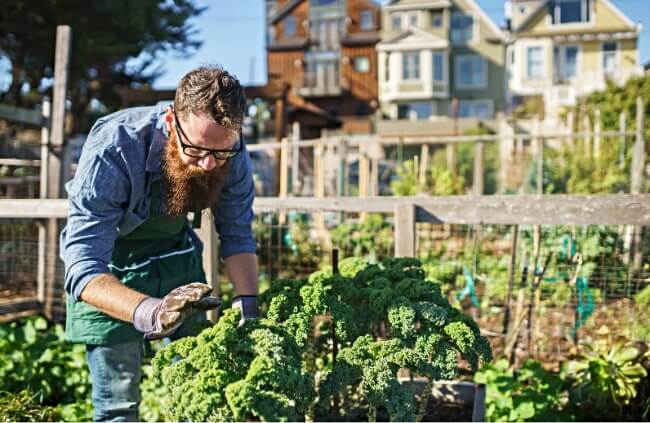
Family: | Brassicacea |
|---|---|
Genus: | Brassica |
Species: | B. oleracea |
Common names: | Leaf cabbage, Kale |
Origin: | Mediterranean Europe and Asia |
Location: | Outdoor |
Type: | Herbaceous perennial, edible |
Growth: | Up to 3m tall |
Sun requirements: | Full sun to light shade |
Foliage colour: | Varied, typically green |
Flower colour: | Yellow |
Flowering: | Early Spring |
Edible parts: | All parts are edible |
Maintenance level: | Low |
Poisonous for pets: | No |
What is Kale?
With a few vegetables, the fear of the unknown can stop us from trying out new things. Kale however isn’t a new vegetable and has been in cultivation since 2000 BC. It was just as popular as other brassicas until it started to get overlooked.
The interesting thing about kale is, it technically doesn’t exist in nature in the form that we know it.
Kale, often referred to as leaf cabbage, is in the Brassicacea family which includes cabbages, broccoli, cauliflower, brussel sprouts and mustards. This wide family is promiscuous and can easily be bred with each other, creating beautiful and exciting things like kale and kalettes (a cross between kale and brussel sprouts).
Reasons to Grow Your Own Kale
Kale is typically known to form leaves of different shapes, colours and sizes but no main ball or head. It helps to sustain harvests as most kale is very cold tolerant so will grow fresh leaves and supply domestic and commercial growers alike throughout the ‘hungry gap’.
This humble vegetable is increasingly being used as our changing climate brings unstable weather patterns, Kale is able to withstand most of what nature can throw at it, meaning a constant, successful and reliable crop.
But apart from this, Kale is a gourmet vegetable. Seasoned kale growers will be familiar with the many varieties you can grow and how each variety has its own unique uses.
The intensely textured Dwarf Green Curled Kale is made for deliciously crispy chips whereas the Rainbow Candy Crush and Candy Floss Kale is championed in a simple but alluring summer garden salad. And it’s these colourful creations that give kale its ornamental edge.
Kales are often used in edimental planting combinations where edibles meet ornamentals. People want both attractive and functional as sometimes there’s not enough space or time for both.
Kale definitely serves this edimental purpose and nothing compares to your own, homegrown food that actually looks good and is incredibly beneficial to our health.
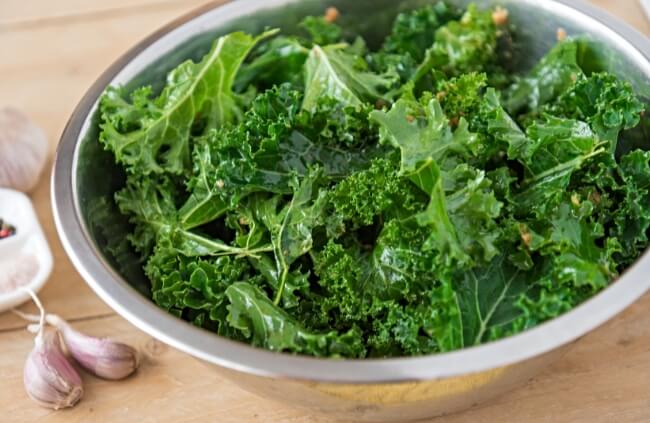
What is Kale’s Natural Habitat?
Kale belongs to the group Brassica oleracea which are all typically grown for their edible leaves. Its closest relative is thought to be wild cabbage, Brassica oleracea var. acephala (commonly known as colewort) from which a lot of the cultivars known today are bred.
This wild cabbage is native to southern and Western Europe and is mainly found along coastal regions.


Get Your Free Guide:
Master Growing Australian Natives eBook
A Must Have Complete Guide for Every Australian Garden
Get Your Free Guide:
Master Growing Australian Natives eBook
A Must Have Complete Guide for Every Australian Garden
Having the ability to tolerate low temperatures down to -15°C and resilience to salt winds and harsh environments come from this coastal heritage. However, the kale we grow today will have different preferences and certain kales are bred for different climates.
Cavolo nero is an Italian kale so will want a warmer climate, whereas its newer bred relative Black Magic is more suited to growing in a colder climate like the UK.
Identifying Kale Vs Other Brassicas
Probably the most well-known kale is Cavolo Nero or Black Tuscan kale with its dark, heavily textured and substantial leaves. All kales have different leaves and are bred specifically for this variation, however they will all typically have a central thick stem with leaves branching from this.
In their first year, they grow leaves, their second will be for flowering and setting seed. They will form long stems and display small clusters of delicate and beautiful, four-petalled yellow flowers that pollinators relish.
Following this, elongated and thin seed pods hold small brown, rounded seeds. Growing kale in abundance will really make you appreciate the fragrance of these flowers, with their sweet honey and vanilla fragrance it’s no wonder bees love them.
In general, kale does grow fast and is typically very easy to grow, but they’re all unique characters. There’s no one-size-fits-all for kale. There’s so much choice in height, size, shape, colour and culinary use there’s a kale for every space.
Common Uses of Kale
The most common use of kale is for eating. However, some varieties are so well bred that they deliver on both flavour and their decorative and ornamental quality.
Firstly, kale is grown for its health benefits. It’s nutritious, being high in vitamins C and K and high in beta-carotene among other antioxidants, and it’s low in calories!
Studies based around kale’s benefits regularly show that including dark leafy vegetables such as kale in your regular diet can trigger changes in your DNA slowing ageing, preventing illness and lowering your cholesterol, increasing general well-being.
Arguably, it is equally beneficial when used as an ornamental in both gardens and vegetable plots. Kale is being increasingly used in show gardens to encourage people to plant it within their borders.
A lot of kales grow quickly and can give great structure in a fast way. And if not enjoyed by you, they’re a great resource for the wildlife too.
The Best Kale Varieties to Grow in Australia
Below are just three of the fantastically varied kale varieties you can grow at home. We grow them all here regularly with great success. For more inspiration, head to our list of 25 kale varieties to grow at home in Australia.
1. Cavolo Nero
Cavolo nero is a robust, reliable kale, known for its dark and flavour-packed leaves. Cavolo nero grows to 1m tall in most gardens and will flower to 1.5m in spring if you leave it to set seed.
Lacinato kale, dinosaur kale and Tuscan kale are all common names for this traditional Italian variety.
2. Peacock Kale
Peacock kale is almost always grown as an ornamental, but the leaves are edible. Personally, I find them too bitter, but it’s still worth growing to get a feel for how varied these leafy green vegetables can be.
3. Amara Kale
Ethiopian kale, or Amara kale, is a different brassica species altogether but grows well when treated, grown and prepared like kale.
Its subtle garlic flavour is more rounded than other kales, and for anyone who struggles to enjoy the sharp brassica flavour of Cavolo nero or curly leaf kales, this is a brilliant alternative that grows well in most of Australia.
How to Grow Kale in Australia
Growing kale is easy and if more people knew how easy it was I’m sure everyone would give it a try. Whether you’re new to growing kale or you’re looking for ways to optimise your crop, here we will outline a few steps towards growing the healthiest and most beautiful plants yet.

How to Propagate Kale
There are a couple of ways kale is propagated, and the most common one tends to be from seed. Hopefully, this information will help you to create healthy new plants that are low cost or even free.
Kale Propagation from Seeds
Sowing kale seed is the typical way to grow this lovely leafy vegetable. Firstly choose the variety you want as there’s a lot of choice. If you’re overwhelmed by the selection, check the height or width of the plant. Smaller plants are often more manageable.
Seeds are to be sown in the coolest part of the growing season. In northern Australia sow seeds in early July. In temperate regions, seed can be sown in Autumn through to Spring.
Sprinkle seeds sparingly onto peat-free compost or potting mix and cover with a sieved layer of compost or vermiculite. Once germinated, thinning may be required if your seedlings are too close together. Keep well watered until true leaves appear.
Once your kale seedling has developed leaves that look similar to the plant it will become, you can prick out your seedling and pot up.
Propagating Kale from Cuttings
Kale can also be successfully grown from cuttings. This is especially successful with perennial varieties like Cottagers Kale or Daubenton's Green. The best time to take kale cuttings is either when your kale plant is beginning to grow on well and has formed several healthy leaves.
Simply by nipping out the top of the plant, you’ll gain a healthy cutting and encourage your kale to become a multi-stemmed plant. Include several nodes in the cutting and root in a free draining, peat-free potting mix. This however won’t work for short ornamental varieties.
Another good time to take a cutting is when you have a fully mature plant and it begins to send little shoots or ‘plantlets’ from the main stem. These can be cleanly cut off and prepared for use as a cutting.
The lower leaves should be stripped off and you can then insert them into free-draining peat-free compost. Snipping the very top of the plant when taking cuttings can discourage the plant from flowering and encourage new fresh growth.
Both ways will result in plants rooting within a few weeks if they’re kept well-watered and in a shaded and protested environment.
Ideal Conditions for Growing Kale
However you started your kale, planting out into the garden is the same. Follow our simple guide below to get your soil just right, and find the right spot for your kale patch.
Soil & Drainage
Kale has a reputation for not being fussy, in that it will grow in all soil types. Kale is very easy to grow but if you want your kale to thrive, it would prefer to grow in a pH of 6-7.5 (a fairly neutral soil).
The soil structure should be moist but not overly soggy, with an average fertility. All cabbages like to have their roots firmly set in the earth so providing friable soil will give it a chance to develop a wide root system.
Light & Temperature
Kale can tolerate quite low temperatures and some are more resistant than others. Light frost will also sweeten kale leaves. The other extreme, very hot weather, may cause your kale to prematurely bolt and go to seed so keep well watered and consider some protection from extreme sun and heat.
Growing your kale in full sun will ensure the best supply of leaves, but the plants will do fairly well in part shade also.
Shelter
Whenever you see kale grown in large numbers it always tends to be netted or protected by some sort of covering. This is to deter pests from laying their eggs which will decimate the plant's leaves.
Providing this protection isn’t essential if you’re growing your plants for decorative reasons, but you may have to sacrifice a few leaves to the caterpillars. Particularly tall varieties may need staking in high winds as they can become too heavy.
Protection from extreme prolonged snow would be beneficial as the weight of heavy snow on tall plants can bend and snap off leaves and in the worst case, bend and break the main stem.
Regular checking and brushing off any layer of snow will help keep the weight off the plant.
Planting Kale
Make sure you are fully aware of the variety you have chosen before preparing your planting hole. This is because you’ll need to give your kale the space it needs to develop both in height and width.
Dig a deep hole in the position you will plant your kale and infill up to the first leaves of your kale plant. Kales are shallow rooting so burying the plants in this way will anchor them into the ground well.
Young plants can benefit from staking as their main stems will be soft and immature and possibly prone to snapping in the wind. Water kale frequently in its first week and continue with a balanced fertiliser when needed.
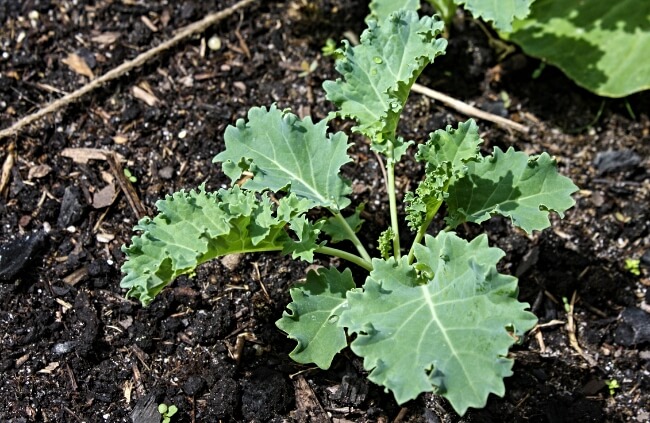
Kale Companion Planting
Creating a diverse planting situation around your kale will attract all the best insects and deter all those unwanted pests. Choosing certain companion plants to either plant around the border of a bed or within and underneath your kale will benefit your crops and surrounding ecology.
- Thanks to their sulphurous compounds, chives will deter whitefly that colonise the undersides of kale leaves and suck at the sap.
- Nasturtiums will attract cabbage white butterflies who lay their eggs in leaves, leaving the subsequent caterpillars to eat the nasturtium rather than your kale leaves.
- Marigolds will act as a sacrificial plant that slugs and snails can munch on instead of your kale.
- Garlic, wild or cultivated, will confuse and deter pests and provide a scent barrier masking the small of your kale. Spring onions will also do this job well.
How to Care for Kale
This humble brassica isn’t known for being hard to care for. Once planted, kale is really straightforward to grow, but make sure you know the basics of what your kale wants will make for healthy and resilient plants.
Mulching Needs
Giving your plants a good layer of mulch, especially in hot weather, will lock in all that much-needed water and stop it from evaporating too quickly. Mulching through the growing season with organic compost offers fertiliser for developing plants too.
What Fertiliser to Use
Balanced fertilisers every few weeks will keep your kales growing and producing fresh leaves as these larger plants need a good supply of nutrients. A great way to give your plants a boost is to use a comfrey fertiliser that you can make at home for free.
This is so simple to make, organic and totally worth the horrible smell it makes, trust me.
Watering Kale
Kale doesn’t need a significant amount of water, but a consistent routine will provide all the hydration it needs, especially in warmer weather. Water deeply once a week as a basic rule, but adapt to your soil conditions, and try not to let the soil dry out completely.
Repotting Kale
If your kale has outgrown the container it’s in or needs potting you as a young plant, repotting is essential. This gives you a chance to include new, peat-free compost for added nutrients alongside extra space for its roots to grow into.
Harvesting & Storing Kale
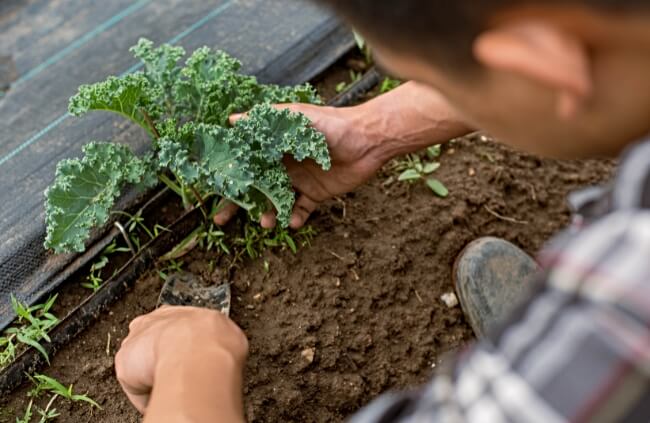
The best time to harvest your kale is always as close to when you're going to use it as possible. This is just so you get the freshest leaves with the best texture.
Some kales will differ in their length to fill maturity. However, a lot of kales can be harvested even in baby leaf form so it’s really up to you and what you prefer. For the health of the plant, it’s wise to let it establish itself first.
Certain plants are bred for fast growth and shorter leaf spacing such as White and Red Russian kale, these varieties may tolerate a more vigorous harvest. However, it is important not to pick too many leaves at once as the plant will need some to photosynthesize.
If harvesting for a later date, wrap your kale leaves in tissue, place them in an airtight bag and put them in the crisper drawer of your refrigerator.
Common Problems When Growing Kale
Commonly not a very problematic plant to grow at home, kale is bred to give us the strong and resilient plants we want. But sometimes things go wrong as it’s hard to diagnose the problem.
Hopefully, the common kale growing problems outlined here will help you figure out what’s ailing your kale.
Wind rock
Plants can become too heavy and without proper firming in, kale can rock around in the wind breaking those fine feeding roots. These roots are responsible for a lot of nutrient transfer so without these, the plant may slowly starve.
Symptoms include yellowing leaves, wilted leaves, slow growth and lack of lustre. Staking your kale can help, along with creating windbreaks around your kale so it’s not as exposed.
Often, we protect kale plants from pests with netting or fleece. These structures can all aid towards a kale with its roots firmly set in the ground.
Overwatering
Kale likes moisture-retentive soil but between watering this needs to be free draining. If the drainage isn’t adequate the plants can suffer and growth will slow. Lower leaves will quickly yellow or begin to look mottled.
Making sure your kale has good drainage between waterings will help. Also, remove any mulch so the soil can allow for evaporation and rebalance itself.
Underwatering
Wilted leaves will be the main sign of an under watered plant. Symptoms are the same as over-watering; yellowing leaves. If the plant is container grown, the soils may have dried out so much it becomes hydrophobic and actually repels water.
If possible, submerge the plant's roots and soil in water and leave until the water bubbles stop. This should help saturate the soil.
Premature bolting
If your kale has bolted and gone to seed before its time, then it’s stressed in some way. This may be temperature, either too hot or too cold. Or even from overwatering or underwatering. Either way, it’s time to re-sow!
Kale suffers from nearly all common garden pests, but there are three in particular that cause significantly more damage than others. In all cases, the best preventions are biodiversity in your garden, and homemade garlic tea sprayed directly onto the leaves.
Cabbage White Butterflies
This beautiful white butterfly can unfortunately wreak havoc on your kale. You’ll find them hovering around anything cabbagy, they love the whole family. They are white butterflies with blackish markings on their wings that lay their eggs on your kale.
You’ll notice holes in your leaves before you see these caterpillars as they are perfectly kale coloured and blend in well. They are easier to find on darker purple or red kales, but the best way to tackle them is to pick them off. Make a day of it.
Slugs and Snails
The gardener’s nemesis. Easy to spot but hard to get rid of. They will typically leave holes all over your kale leaves and, the cherry on the cake, their poo too. All known slug barriers are a good start but nothing beats going out in the dark and picking them off. Make a night of it.
Whiteflies
These small white flies are scale-like insects that colonise the underside of your kale. Infestations can lead to mottled leaves as these flies suck the juices from the leaves, draining and weakening the plant and often transferring diseases from other plants
The quickest and most effective way to get rid of whitefly is to get a handheld pressure sprayer and blast them with water into a bucket.
Kale can succumb to various blights and fungal issues like verticillium, but the biggest problem is club root. Below we’ll look at the most common kale diseases, and how to prevent or cure them.
Club Root
Club root is a soil-borne fungus that you won’t know you have until you start growing cabbages or anything in the brassica family on that soil. Club root turns the roots into a distorted clump that renders them incapable of developing. Your kale will eventually wilt and die.
Ways to prevent club root include practising thorough crop rotation and growing your own plants from seed and sterile compost. Lining the soil prior to planting can help as a precaution in raised beds too.
Once club root is present in your soil, it is very hard to eradicate but it is possible, provided you avoid planting brassicas in that spot for at least four years.
Downy Mildew
Downy Mildew affects a lot of flat-leaved kales, with fluffy mildew coating several leaves. The fungal problem can be left to die back by itself in warm weather, but in continuing humidity, it's best to remove the affected leaves and burn them to stop it from spreading to the rest of your garden.
Downy mildew is a fungal infection that can only attach itself to wet or humid leaves, so always water your kale at the base of the plant and avoid using sprinklers to water.
Rust
Rust is a general term for several fungal problems in the vegetable garden, and it is easy to spot because it looks rusty. The orange spots start, usually at the site of pest damage, and spread to cover the whole leaf, and eventually stem of the plant.
Cutting sections of rust off your plant is essential when you see it to prevent further spread as it isn’t just limited to kale.
Organic pest control measures will prevent the spread of rust. Introducing or encouraging predatory insects by planting umbellifer flowers around the garden is a surefire way to reduce aphids and whitefly (the most common spreaders of rust and mildew).
Kale Frequently Asked Questions
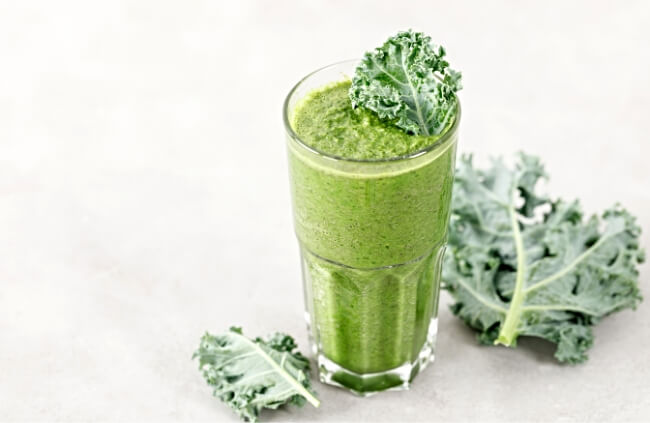
What is the best time to plant kale?
The best time to plant kale is early spring or late autumn. Planting kale either side of the summer means you’ll have a continuous crop, and early harvests next season.
Does kale regrow after cutting?
Kale continues to grow upwards until it reaches its maximum height (this varies from cultivar to cultivar), but by regularly picking leaves you encourage more to grow. When your kale plant gets to its full height, you can cut back to a set of young leaves, or any young side shoots, which will grow into a new main stem.
How long does it take to grow kale?
Kale takes about 60-70 days from sowing to the first harvest, and many varieties will crop for a full year afterwards, and even become short-lived perennial plants.
If you’re really impatient though, you can get that kale flavour quickly by densely sowing kale seeds into a tray of coir compost and harvest kale sprouts or young leaves as microgreens within two weeks.
Does kale come back every year?
Most kale varieties are short-lived perennials or biennials, flowering in their second year and then dying back. Cottager’s kale is the most famous example of perennial kale, and it will reliably come back with a fresh harvest each year.
How do I grow kale in pots?
Growing kale in pots is simple. Fill your pot with peat-free compost, and sow seeds directly into the pot. Use a large enough pot for your plant to develop (a 30cm wide pot is enough for one cavolo nero plant or three dwarf curly plants).
Can kale get too much sun?
Like any leafy green, kale can get too much sun. If you are expecting a particularly hot dry spell, make sure to water your kale well in the mornings. This will help to reduce foliage damage, and prevent any chance of young plants bolting in their first year.
Why is my kale bolting?
Kale seedlings and kale plants kept in small containers for too long bolt due to stress. They have fine, fibrous roots that are easy to miss when you dig the plant up as most tear off in the soil.
But for seedlings left in their containers, they bolt when they become pot-bound. For plants in the ground, they can bolt as a response to severe hot weather.
Should I pinch off kale flowers?
If your kale is flowering in its first year, pinch the flowers off when you see buds forming. Remove the buds, the flowering stems, and a few young leaves from below where the flowers emerged.
Then water the plants well, and keep an eye on them - you may have to keep pinching flowers off.
Transform Your Garden into a Superfood Haven with Kale
Nothing gives you that feeling of homegrown produce, picked moments before eating. Growing your own gives so many new possibilities that you would never find in a supermarket. When it’s as easy and as satisfying as kale is to grow, why not devote a small space in your garden to this leafy legend.
The best thing about kale is its versatility. It's like the potato of the leaf world. Fried, sautéed, souped and smoothied, there’s a variety that suits all needs and your perfect dream kale is out there waiting for you to grow it.
Published on June 5, 2024 by Maisie Blevins
Last Updated on September 20, 2024




